Comparing Confucian Ren and Daoist Wuwei in East Asian Religions
VerifiedAdded on 2020/04/15
|5
|1403
|330
Essay
AI Summary
This essay delves into the philosophical and spiritual ideas within East Asian religions, focusing on Confucianism, Daoism, and their impact on family rapport. It contrasts the cultivation of Confucian 'ren' and Daoist 'wuwei' in relation to the concept of family, examining how cultural, natural, and spiritual aspects of interaction have shaped these traditions. The essay explores the influence of Buddhism on Chinese traditions, the transformation of Japanese identity, and the unique Japanese rapport with the natural world. It considers both inner and outer pressures, such as tensions within ideas and challenges from foreign influences, and concludes by highlighting the diverse understandings of what it means to be human within these East Asian traditions. The essay also references the interplay between Confucianism, Daoism, and Shinto, their historical evolution, and their enduring impact on human identity and rapport with the environment.
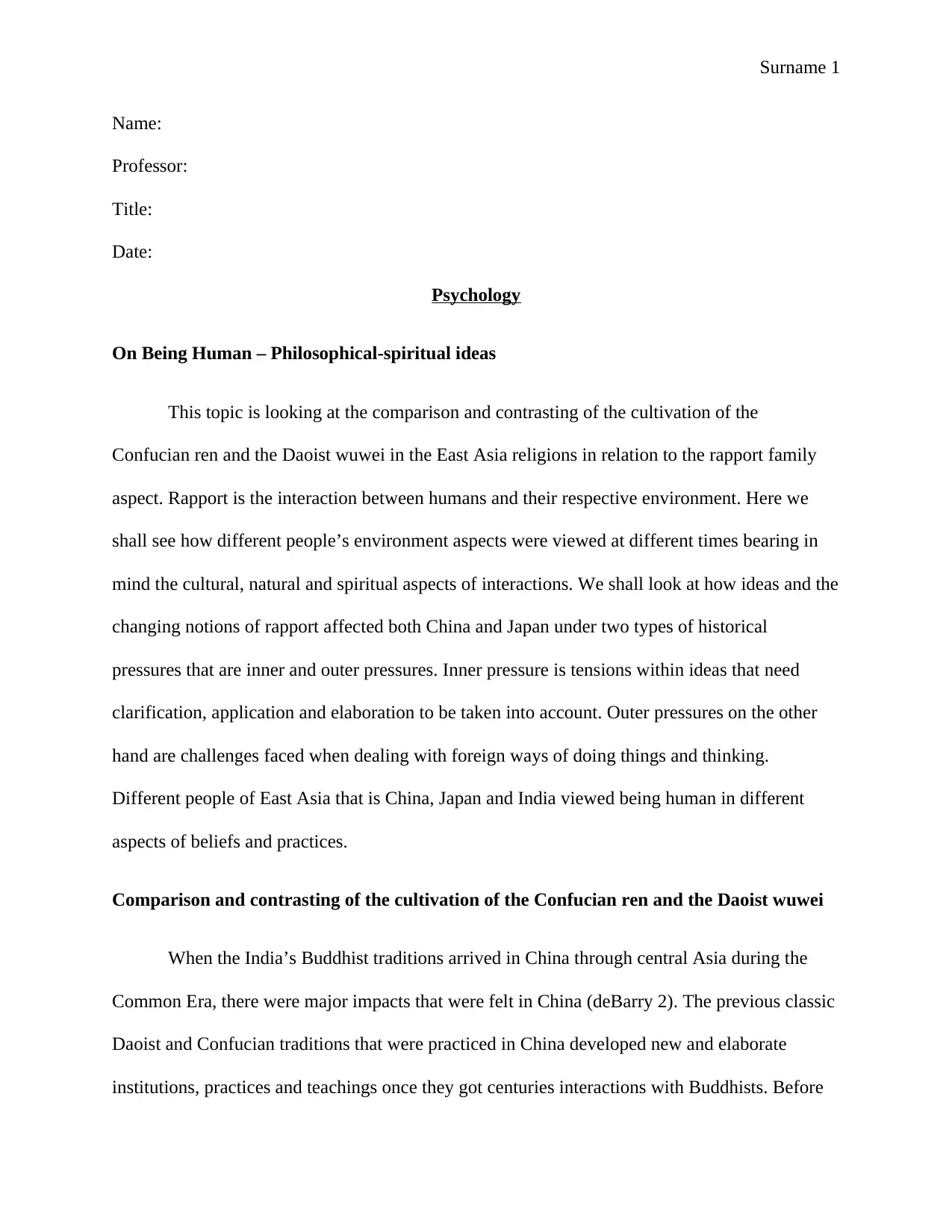
Surname 1
Name:
Professor:
Title:
Date:
Psychology
On Being Human – Philosophical-spiritual ideas
This topic is looking at the comparison and contrasting of the cultivation of the
Confucian ren and the Daoist wuwei in the East Asia religions in relation to the rapport family
aspect. Rapport is the interaction between humans and their respective environment. Here we
shall see how different people’s environment aspects were viewed at different times bearing in
mind the cultural, natural and spiritual aspects of interactions. We shall look at how ideas and the
changing notions of rapport affected both China and Japan under two types of historical
pressures that are inner and outer pressures. Inner pressure is tensions within ideas that need
clarification, application and elaboration to be taken into account. Outer pressures on the other
hand are challenges faced when dealing with foreign ways of doing things and thinking.
Different people of East Asia that is China, Japan and India viewed being human in different
aspects of beliefs and practices.
Comparison and contrasting of the cultivation of the Confucian ren and the Daoist wuwei
When the India’s Buddhist traditions arrived in China through central Asia during the
Common Era, there were major impacts that were felt in China (deBarry 2). The previous classic
Daoist and Confucian traditions that were practiced in China developed new and elaborate
institutions, practices and teachings once they got centuries interactions with Buddhists. Before
Name:
Professor:
Title:
Date:
Psychology
On Being Human – Philosophical-spiritual ideas
This topic is looking at the comparison and contrasting of the cultivation of the
Confucian ren and the Daoist wuwei in the East Asia religions in relation to the rapport family
aspect. Rapport is the interaction between humans and their respective environment. Here we
shall see how different people’s environment aspects were viewed at different times bearing in
mind the cultural, natural and spiritual aspects of interactions. We shall look at how ideas and the
changing notions of rapport affected both China and Japan under two types of historical
pressures that are inner and outer pressures. Inner pressure is tensions within ideas that need
clarification, application and elaboration to be taken into account. Outer pressures on the other
hand are challenges faced when dealing with foreign ways of doing things and thinking.
Different people of East Asia that is China, Japan and India viewed being human in different
aspects of beliefs and practices.
Comparison and contrasting of the cultivation of the Confucian ren and the Daoist wuwei
When the India’s Buddhist traditions arrived in China through central Asia during the
Common Era, there were major impacts that were felt in China (deBarry 2). The previous classic
Daoist and Confucian traditions that were practiced in China developed new and elaborate
institutions, practices and teachings once they got centuries interactions with Buddhists. Before
Paraphrase This Document
Need a fresh take? Get an instant paraphrase of this document with our AI Paraphraser
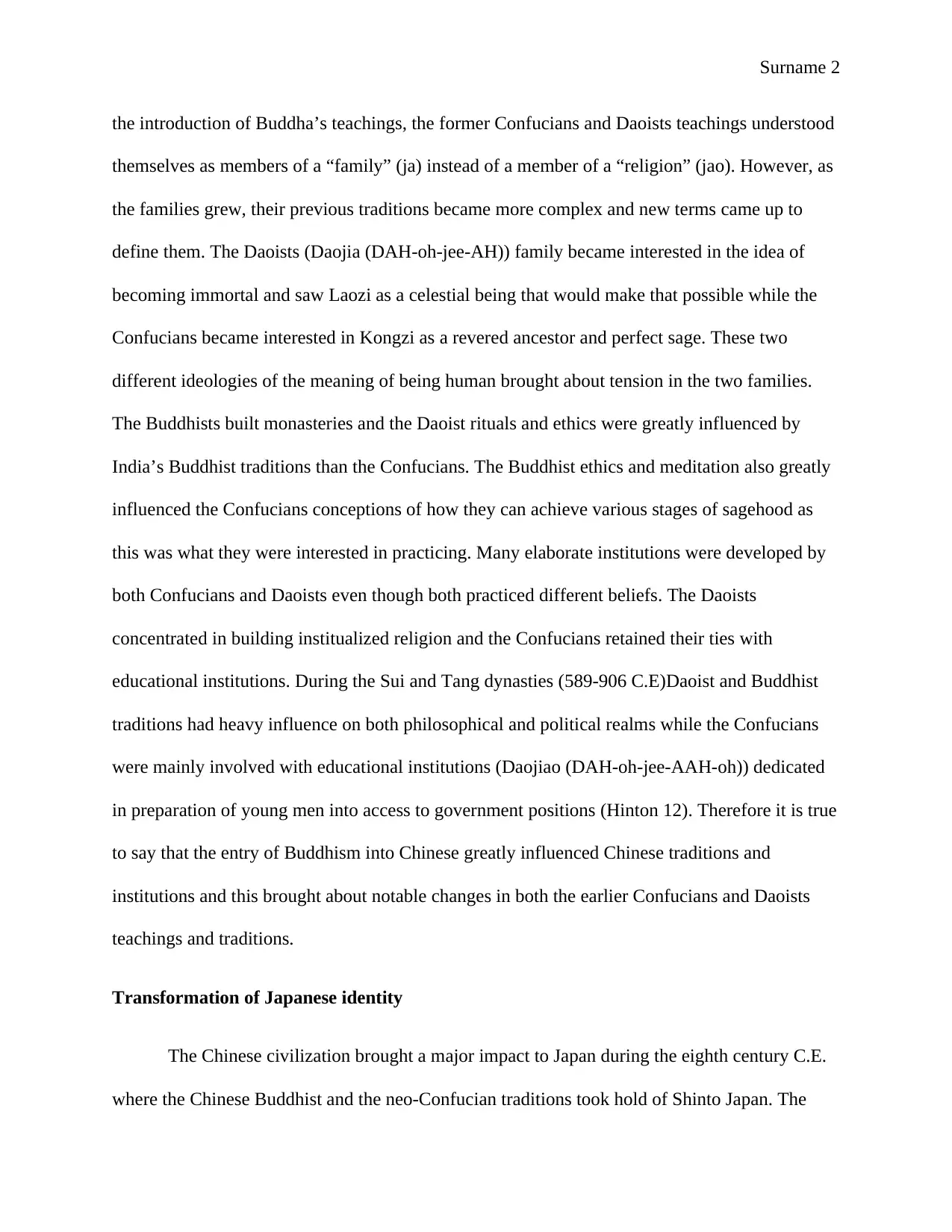
Surname 2
the introduction of Buddha’s teachings, the former Confucians and Daoists teachings understood
themselves as members of a “family” (ja) instead of a member of a “religion” (jao). However, as
the families grew, their previous traditions became more complex and new terms came up to
define them. The Daoists (Daojia (DAH-oh-jee-AH)) family became interested in the idea of
becoming immortal and saw Laozi as a celestial being that would make that possible while the
Confucians became interested in Kongzi as a revered ancestor and perfect sage. These two
different ideologies of the meaning of being human brought about tension in the two families.
The Buddhists built monasteries and the Daoist rituals and ethics were greatly influenced by
India’s Buddhist traditions than the Confucians. The Buddhist ethics and meditation also greatly
influenced the Confucians conceptions of how they can achieve various stages of sagehood as
this was what they were interested in practicing. Many elaborate institutions were developed by
both Confucians and Daoists even though both practiced different beliefs. The Daoists
concentrated in building institualized religion and the Confucians retained their ties with
educational institutions. During the Sui and Tang dynasties (589-906 C.E)Daoist and Buddhist
traditions had heavy influence on both philosophical and political realms while the Confucians
were mainly involved with educational institutions (Daojiao (DAH-oh-jee-AAH-oh)) dedicated
in preparation of young men into access to government positions (Hinton 12). Therefore it is true
to say that the entry of Buddhism into Chinese greatly influenced Chinese traditions and
institutions and this brought about notable changes in both the earlier Confucians and Daoists
teachings and traditions.
Transformation of Japanese identity
The Chinese civilization brought a major impact to Japan during the eighth century C.E.
where the Chinese Buddhist and the neo-Confucian traditions took hold of Shinto Japan. The
the introduction of Buddha’s teachings, the former Confucians and Daoists teachings understood
themselves as members of a “family” (ja) instead of a member of a “religion” (jao). However, as
the families grew, their previous traditions became more complex and new terms came up to
define them. The Daoists (Daojia (DAH-oh-jee-AH)) family became interested in the idea of
becoming immortal and saw Laozi as a celestial being that would make that possible while the
Confucians became interested in Kongzi as a revered ancestor and perfect sage. These two
different ideologies of the meaning of being human brought about tension in the two families.
The Buddhists built monasteries and the Daoist rituals and ethics were greatly influenced by
India’s Buddhist traditions than the Confucians. The Buddhist ethics and meditation also greatly
influenced the Confucians conceptions of how they can achieve various stages of sagehood as
this was what they were interested in practicing. Many elaborate institutions were developed by
both Confucians and Daoists even though both practiced different beliefs. The Daoists
concentrated in building institualized religion and the Confucians retained their ties with
educational institutions. During the Sui and Tang dynasties (589-906 C.E)Daoist and Buddhist
traditions had heavy influence on both philosophical and political realms while the Confucians
were mainly involved with educational institutions (Daojiao (DAH-oh-jee-AAH-oh)) dedicated
in preparation of young men into access to government positions (Hinton 12). Therefore it is true
to say that the entry of Buddhism into Chinese greatly influenced Chinese traditions and
institutions and this brought about notable changes in both the earlier Confucians and Daoists
teachings and traditions.
Transformation of Japanese identity
The Chinese civilization brought a major impact to Japan during the eighth century C.E.
where the Chinese Buddhist and the neo-Confucian traditions took hold of Shinto Japan. The
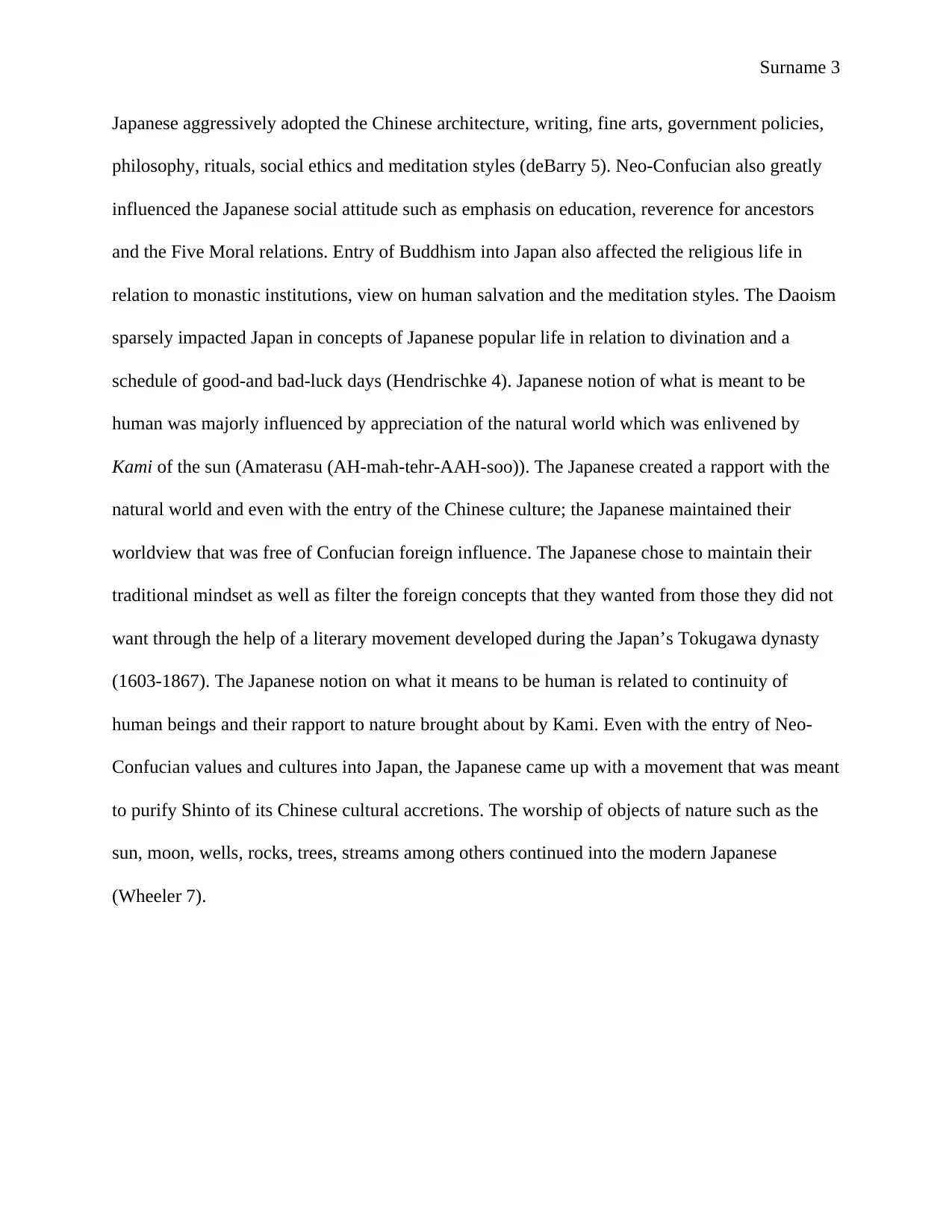
Surname 3
Japanese aggressively adopted the Chinese architecture, writing, fine arts, government policies,
philosophy, rituals, social ethics and meditation styles (deBarry 5). Neo-Confucian also greatly
influenced the Japanese social attitude such as emphasis on education, reverence for ancestors
and the Five Moral relations. Entry of Buddhism into Japan also affected the religious life in
relation to monastic institutions, view on human salvation and the meditation styles. The Daoism
sparsely impacted Japan in concepts of Japanese popular life in relation to divination and a
schedule of good-and bad-luck days (Hendrischke 4). Japanese notion of what is meant to be
human was majorly influenced by appreciation of the natural world which was enlivened by
Kami of the sun (Amaterasu (AH-mah-tehr-AAH-soo)). The Japanese created a rapport with the
natural world and even with the entry of the Chinese culture; the Japanese maintained their
worldview that was free of Confucian foreign influence. The Japanese chose to maintain their
traditional mindset as well as filter the foreign concepts that they wanted from those they did not
want through the help of a literary movement developed during the Japan’s Tokugawa dynasty
(1603-1867). The Japanese notion on what it means to be human is related to continuity of
human beings and their rapport to nature brought about by Kami. Even with the entry of Neo-
Confucian values and cultures into Japan, the Japanese came up with a movement that was meant
to purify Shinto of its Chinese cultural accretions. The worship of objects of nature such as the
sun, moon, wells, rocks, trees, streams among others continued into the modern Japanese
(Wheeler 7).
Japanese aggressively adopted the Chinese architecture, writing, fine arts, government policies,
philosophy, rituals, social ethics and meditation styles (deBarry 5). Neo-Confucian also greatly
influenced the Japanese social attitude such as emphasis on education, reverence for ancestors
and the Five Moral relations. Entry of Buddhism into Japan also affected the religious life in
relation to monastic institutions, view on human salvation and the meditation styles. The Daoism
sparsely impacted Japan in concepts of Japanese popular life in relation to divination and a
schedule of good-and bad-luck days (Hendrischke 4). Japanese notion of what is meant to be
human was majorly influenced by appreciation of the natural world which was enlivened by
Kami of the sun (Amaterasu (AH-mah-tehr-AAH-soo)). The Japanese created a rapport with the
natural world and even with the entry of the Chinese culture; the Japanese maintained their
worldview that was free of Confucian foreign influence. The Japanese chose to maintain their
traditional mindset as well as filter the foreign concepts that they wanted from those they did not
want through the help of a literary movement developed during the Japan’s Tokugawa dynasty
(1603-1867). The Japanese notion on what it means to be human is related to continuity of
human beings and their rapport to nature brought about by Kami. Even with the entry of Neo-
Confucian values and cultures into Japan, the Japanese came up with a movement that was meant
to purify Shinto of its Chinese cultural accretions. The worship of objects of nature such as the
sun, moon, wells, rocks, trees, streams among others continued into the modern Japanese
(Wheeler 7).
⊘ This is a preview!⊘
Do you want full access?
Subscribe today to unlock all pages.

Trusted by 1+ million students worldwide
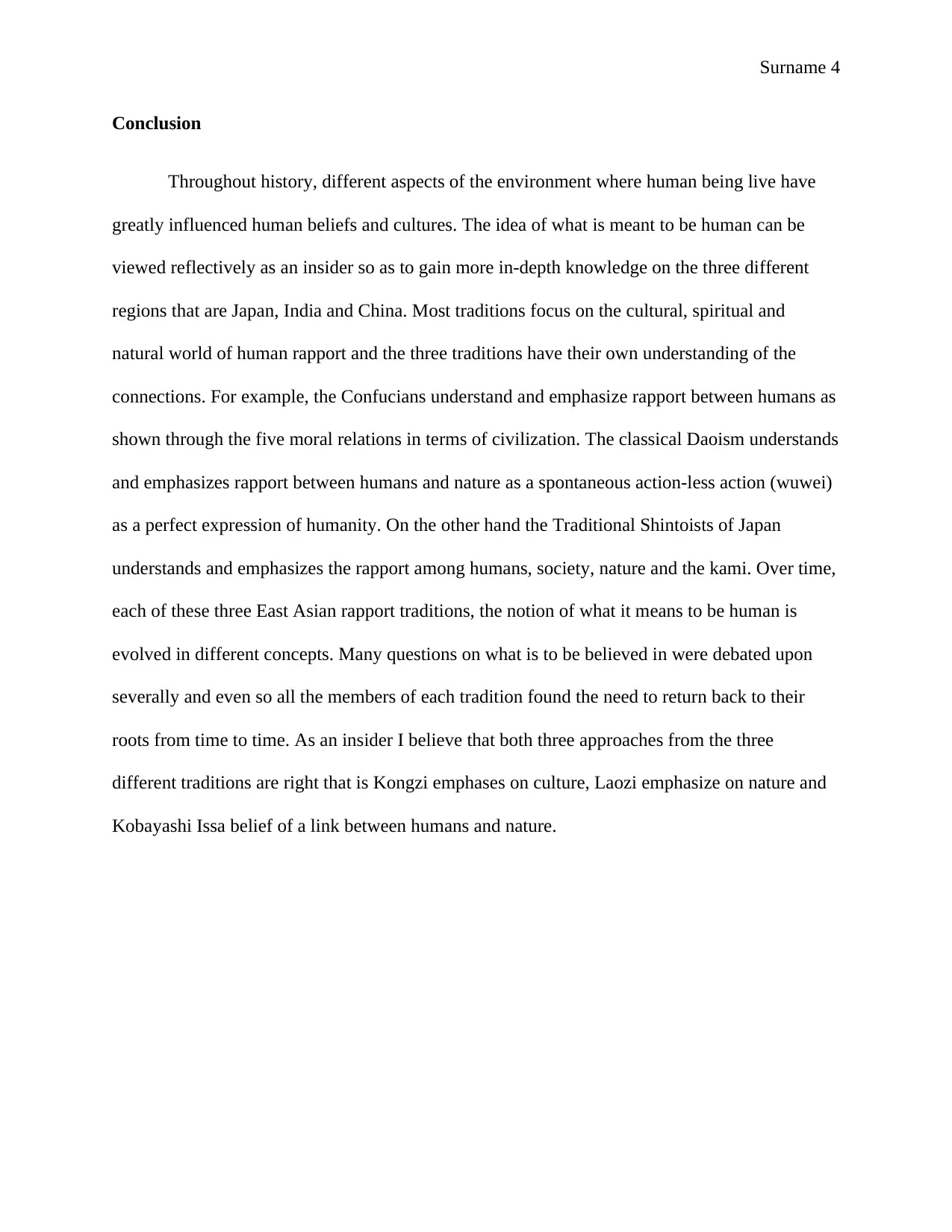
Surname 4
Conclusion
Throughout history, different aspects of the environment where human being live have
greatly influenced human beliefs and cultures. The idea of what is meant to be human can be
viewed reflectively as an insider so as to gain more in-depth knowledge on the three different
regions that are Japan, India and China. Most traditions focus on the cultural, spiritual and
natural world of human rapport and the three traditions have their own understanding of the
connections. For example, the Confucians understand and emphasize rapport between humans as
shown through the five moral relations in terms of civilization. The classical Daoism understands
and emphasizes rapport between humans and nature as a spontaneous action-less action (wuwei)
as a perfect expression of humanity. On the other hand the Traditional Shintoists of Japan
understands and emphasizes the rapport among humans, society, nature and the kami. Over time,
each of these three East Asian rapport traditions, the notion of what it means to be human is
evolved in different concepts. Many questions on what is to be believed in were debated upon
severally and even so all the members of each tradition found the need to return back to their
roots from time to time. As an insider I believe that both three approaches from the three
different traditions are right that is Kongzi emphases on culture, Laozi emphasize on nature and
Kobayashi Issa belief of a link between humans and nature.
Conclusion
Throughout history, different aspects of the environment where human being live have
greatly influenced human beliefs and cultures. The idea of what is meant to be human can be
viewed reflectively as an insider so as to gain more in-depth knowledge on the three different
regions that are Japan, India and China. Most traditions focus on the cultural, spiritual and
natural world of human rapport and the three traditions have their own understanding of the
connections. For example, the Confucians understand and emphasize rapport between humans as
shown through the five moral relations in terms of civilization. The classical Daoism understands
and emphasizes rapport between humans and nature as a spontaneous action-less action (wuwei)
as a perfect expression of humanity. On the other hand the Traditional Shintoists of Japan
understands and emphasizes the rapport among humans, society, nature and the kami. Over time,
each of these three East Asian rapport traditions, the notion of what it means to be human is
evolved in different concepts. Many questions on what is to be believed in were debated upon
severally and even so all the members of each tradition found the need to return back to their
roots from time to time. As an insider I believe that both three approaches from the three
different traditions are right that is Kongzi emphases on culture, Laozi emphasize on nature and
Kobayashi Issa belief of a link between humans and nature.
Paraphrase This Document
Need a fresh take? Get an instant paraphrase of this document with our AI Paraphraser
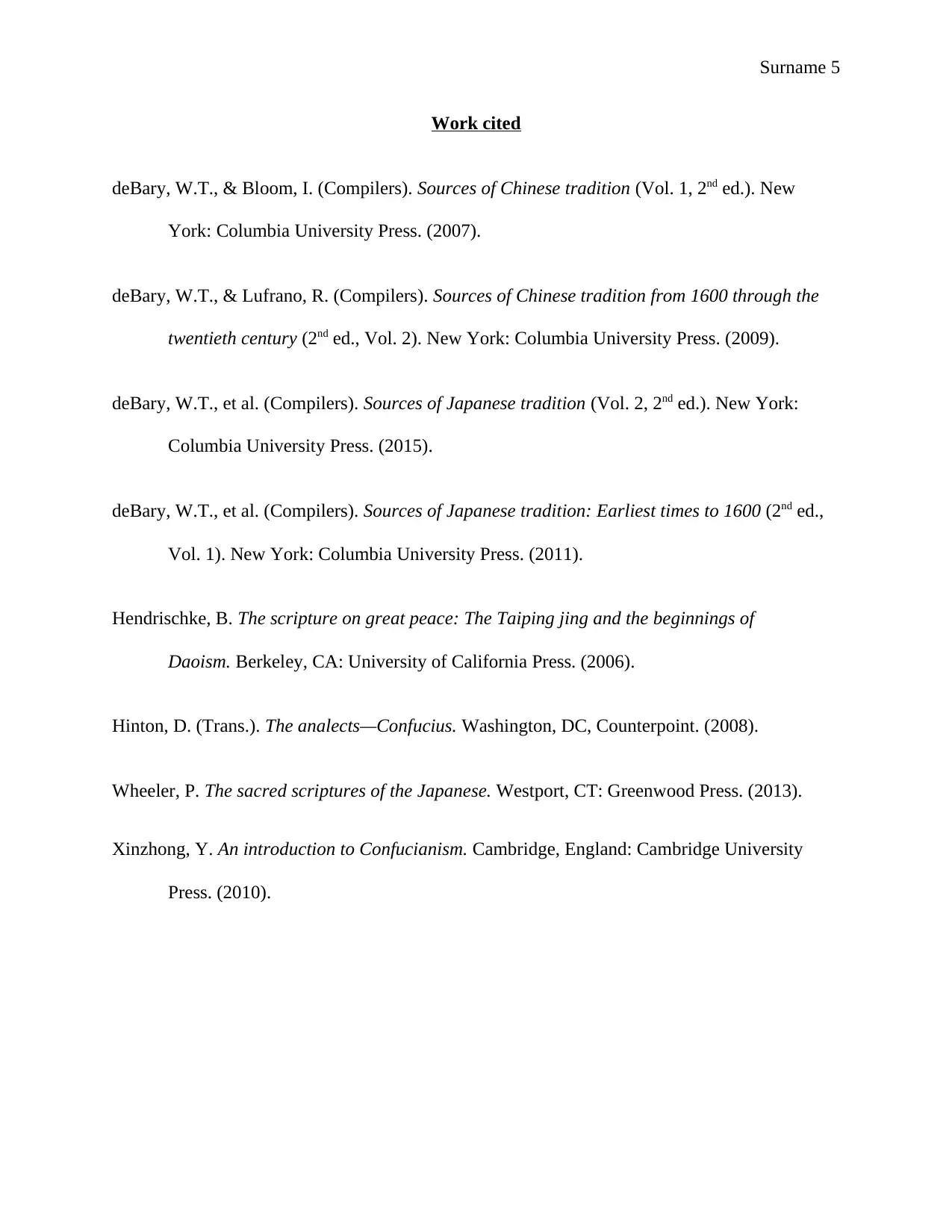
Surname 5
Work cited
deBary, W.T., & Bloom, I. (Compilers). Sources of Chinese tradition (Vol. 1, 2nd ed.). New
York: Columbia University Press. (2007).
deBary, W.T., & Lufrano, R. (Compilers). Sources of Chinese tradition from 1600 through the
twentieth century (2nd ed., Vol. 2). New York: Columbia University Press. (2009).
deBary, W.T., et al. (Compilers). Sources of Japanese tradition (Vol. 2, 2nd ed.). New York:
Columbia University Press. (2015).
deBary, W.T., et al. (Compilers). Sources of Japanese tradition: Earliest times to 1600 (2nd ed.,
Vol. 1). New York: Columbia University Press. (2011).
Hendrischke, B. The scripture on great peace: The Taiping jing and the beginnings of
Daoism. Berkeley, CA: University of California Press. (2006).
Hinton, D. (Trans.). The analects—Confucius. Washington, DC, Counterpoint. (2008).
Wheeler, P. The sacred scriptures of the Japanese. Westport, CT: Greenwood Press. (2013).
Xinzhong, Y. An introduction to Confucianism. Cambridge, England: Cambridge University
Press. (2010).
Work cited
deBary, W.T., & Bloom, I. (Compilers). Sources of Chinese tradition (Vol. 1, 2nd ed.). New
York: Columbia University Press. (2007).
deBary, W.T., & Lufrano, R. (Compilers). Sources of Chinese tradition from 1600 through the
twentieth century (2nd ed., Vol. 2). New York: Columbia University Press. (2009).
deBary, W.T., et al. (Compilers). Sources of Japanese tradition (Vol. 2, 2nd ed.). New York:
Columbia University Press. (2015).
deBary, W.T., et al. (Compilers). Sources of Japanese tradition: Earliest times to 1600 (2nd ed.,
Vol. 1). New York: Columbia University Press. (2011).
Hendrischke, B. The scripture on great peace: The Taiping jing and the beginnings of
Daoism. Berkeley, CA: University of California Press. (2006).
Hinton, D. (Trans.). The analects—Confucius. Washington, DC, Counterpoint. (2008).
Wheeler, P. The sacred scriptures of the Japanese. Westport, CT: Greenwood Press. (2013).
Xinzhong, Y. An introduction to Confucianism. Cambridge, England: Cambridge University
Press. (2010).
1 out of 5
Your All-in-One AI-Powered Toolkit for Academic Success.
+13062052269
info@desklib.com
Available 24*7 on WhatsApp / Email
![[object Object]](/_next/static/media/star-bottom.7253800d.svg)
Unlock your academic potential
Copyright © 2020–2025 A2Z Services. All Rights Reserved. Developed and managed by ZUCOL.